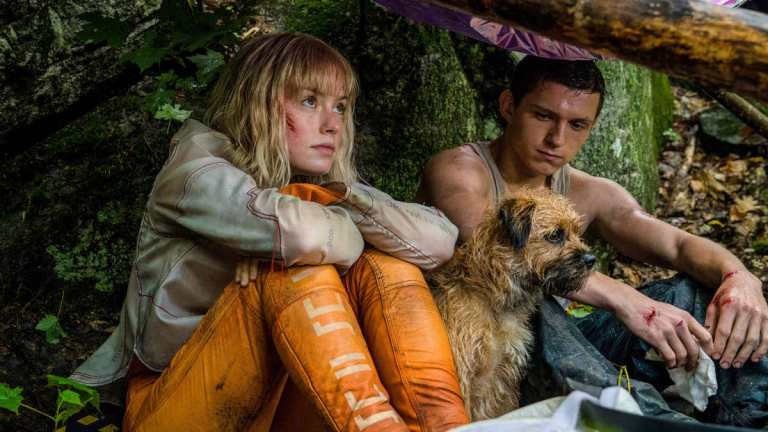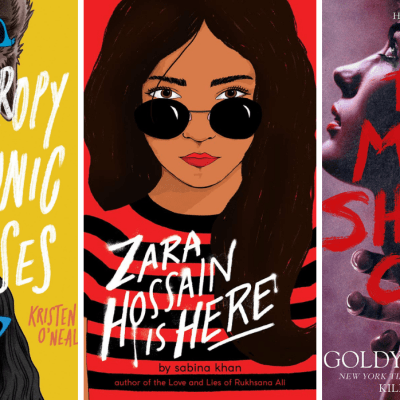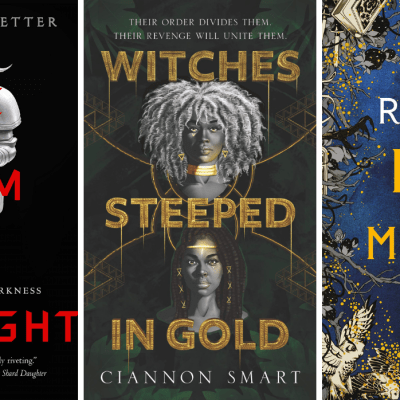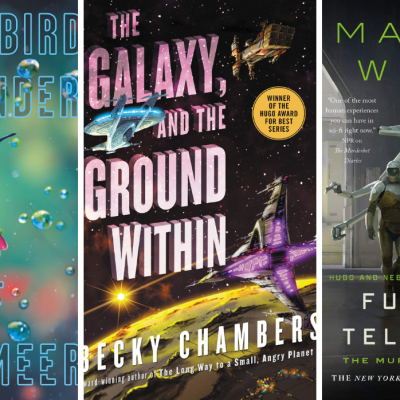“We Have Just Never Listened to Women”: Patrick Ness on Chaos Walking’s Relevance Today
Tom Holland and Daisy Ridley’s sci-fi adaptation of The Knife of Never Letting Go loses the talking dog but keeps the commentary on toxic masculinity and information overload.

Patrick Ness’ 2008 science fiction young adult novel The Knife of Never Letting Go was published the same year as Suzanne Collins’ The Hunger Games, but while the latter launched a dystopian YA franchise, Ness’ Chaos Walking series seemed to attract more of a cult following despite tackling similar early-2000s issues through a speculative lens. While Collins struck an arrow through the heart of reality television, Ness turned his attention to information overload, manifesting it as the Noise: an ever-present broadcast of one’s most private, cringeworthy, hateful, earnest thoughts for all to hear—but only for men.
On the “New World,” an alien planet only recently colonized by humans, the all-male settlement of Prentisstown has ascribed varyingly demanding interpretations of masculinity and morality to their members’ handling of the Noise. Todd Hewitt, the community’s sole boy, must come of age when he faces something even more chaotic than his Noise: the first girl he’s ever seen, a silent space traveler named Viola.
Over a decade later, the book’s dual commentary on information overload and toxic masculinity remains relevant. In fact, as Ness told Den of Geek, the intervening 13 years have only provided more dire inspiration for adapting his novel to the big screen. Doug Liman’s adaptation of Chaos Walking, starring Tom Holland and Daisy Ridley, finally arrives in the UK (it hit the US last month) after a perfect storm of delays, from scheduling around two of the biggest franchise stars to dealing with COVID-19 setbacks. The film conjures a similar lo-fi dystopian setting as Gary Ross’ The Hunger Games film while transforming the book’s free-associating monologue into an ever-present visual and aural halo—not unlike the information overload depicted in more tech-y futuristic tales.
In addition to the forceful depiction of the Noise, Ness spoke with Den of Geek about the book dog’s Noise that didn’t make the final cut, the Western homages behind Mads Mikkelsen’s villainous Mayor Prentiss, and what happens when men don’t listen to women.
DEN OF GEEK: When you first wrote The Knife of Never Letting Go, it was a response to information overload circa 2007. What was it like revisiting the story to adapt it over a decade later?
PATRICK NESS: Gosh, just that the world has gotten so much noisier—that there’s just so much more information coming at us. If the original idea was about questioning how much of ourselves we feel obliged to share and give to the world, that question has only become—not more serious, but we now do it so automatically that I just want to be sure that we keep asking that question: What are we losing, and how much of ourselves do we need to keep our sense of identity? The other big thing that’s happened in the last 13 years is that we’ve all gotten so used to sharing on social media—we’ve gotten so used to what it does, that it’s such a fabric of our lives—that people have now recognized, “I can abuse this. I can use this to tell lies; I can use this to make fake enemies; I can use this to manipulate elections”—for example. The genie isn’t gonna go back into the bottle, and I’m not some doomsayer saying we need to go back to phones and blah blah blah. We need to not forget that we have a choice of what to share and that there are—for all the good things the Internet brings us, which it does—we should not and must not ignore the darker parts of it, because there are very dark parts of it.
That darkness is especially apparent in the culture of Prentisstown and their need to control the Noise. In adapting, did you find yourself approaching Prentisstown differently than when you wrote the book?
Read more
There was always meant to be a feeling of poison in Prentisstown—something has gone amiss here. And in the intervening 13 years, we have only had further and further and further proof of how we have just never listened to women. One after another, we keep having to learn this stupid lesson and then not learning it. And so the feeling of something bad in the well of Prentisstown feels like it became clearer and sharper and more dangerous-seeming, because we have so much proof now of the danger that leads [to]. There isn’t much of a step from dismissing what a woman says, to dehumanizing a woman, to pure misogyny that they have nothing to say—that’s not a long journey. The point of Prentisstown was always to show the most extreme example of what a community might do in reaction to this huge difference between men and women that happens to be made apparent in every communication in this place. But it has only—I think the world has shown us that it’s not that fictional, and that’s a scary thing. Again, the question must be constantly asked, it must be constantly second-guessed and demanded: Why does this happen? Why do we keep doing it, and how do we stop it, and how do we keep stopping it? I’m not acting like I’m some prophet, because that poison was always there, but fortunately there have been some attempts to recently counteract it—and long may that continue.
What you said about information overload and fabricating reality to influence things ties into what made the Noise striking in this movie, especially with regard to characters who can project lifelike objects and people into others’ minds. What was the thought process in depicting the Noise so visually on-screen?
That was the longest conversation, because the Noise is the movie. That’s the thing that has to work. We didn’t want it to be exposition—people sitting around thinking these thoughts that just happen to tell you the history of the planet—because I hate that kind of stuff. So we thought, it’s got to be immersive from the start; you’ve got to be able to see and guess what’s happening before it’s explained to you. My favorite Noise is that of David Oyelowo [whose preacher character’s Noise looks like hellfire]—that’s kind of what we’re after, that it’s an emotional thing, an unfiltered expression of our brains, which are a mess. I think we’re charming messes, humans, really, but without this filter—which is the thing that makes us human, the ability to decide what to say—how much of a mess does that look, because it’s a purely emotional situation. So with that basis, the conversation was always, how do we make it so it’s not confusing or oppressive—because it would be very, very oppressive, if it were real—and how can it be used, how would people have evolved to use it, if they’ve gotten used to manipulating it.
Read more
Lots and lots of special effects tests and approaches, some really cool technology. There was a Noise unit on the film, so Tom would stand in the middle of a circle of cameras capturing him from 360 degrees, linking it up. Then the final results are a combination of all those things: technology, some artwork, some animation. My favorite little bit of it is a scene where Daisy Ridley’s walking up a hill and Tom Holland is behind her, and he’s kinda grumpy about her, and he’s complaining, and you see the complaints kinda just fly off the back of his head. That, to me, is what Noise would be.
Was there anything cut from the book, or an early version of the screenplay, that you would have loved to have seen?
One of my favorite characters in the book is called Wilf; and he does play an important part later in the trilogy, as well. But it’s a 500-page book, and at most a movie is a long short story, so you do have to make sacrifices. But what you get in exchange is, there’s a scene in the film where Tom and Daisy are under a little tarp in the rain, and something very funny happens. And that’s not in the book, but what you get in exchange is something like that, a little scene that expresses a ton that you can do visually, because [that scene] wouldn’t work in a book. I don’t mind; you give and you get. I’ve always viewed adaptations, even when it’s not my own work, as a remix. It’s not a cover version, it’s not an exact replica, it’s a remix. If I can start with that premise, then I can feel more creative.
Was there ever a version in which Todd’s dog Manchee has the Noise, like in the book?
Yes! But what you find out very quickly is that it’s all kind of about real estate. The animal Noise is very funny in the book, to me—it always made me laugh—and in a massive novel of 110,000 words, that real estate in the book doesn’t take up much. A movie is much more compressed, so every time an animal spoke, it just took up so much room in the movie. And it is funny, because it’s meant to be, but it kind of unbalanced the story, and it totally took away from what really needed to happen. Read the book, is what I would say, because I still love the idea, it still makes me laugh; but in a movie, it becomes too cartoon-y. We’re not making The Incredible Journey, as wonderful as it is! So you have to make some sacrifices.
The movie ends differently from the book, which is more of a clear cliffhanger setting up book 2, The Ask and the Answer; whereas the movie is left open-ended for sequels, but on a less dire note. What influenced this decision?
Doug Liman is an exploratory filmmaker; it’s a different approach than any director I’ve ever met. He’s really very much about what’s happening on set, what feels the right energy, where are we going—which is why there’s additional photography in all of his films. That’s always planned, it’s always in advance; we always knew that was going to happen, we just had to schedule the two biggest franchise stars in the world. But because of that, the story tends to organically develop. So we thought, Where are these two going in particular now that we have these actors, we have this situation, and it just starts to slightly change.
And I don’t mind that—again, in the remix idea—but what it interestingly has done is that it’s become more pandemic-themed, unintentionally, in that here are all these people who have been presented with a situation completely beyond their control, so how do they adapt? And there is a hopeful feeling at the end of this film, one I think is true, because they’ve really earned it, but also it’s like what we’ve done—we’re talking via Zoom, we’ve adjusted. It’s not perfect, and we’re all waiting for a better world, but we’re also probably not gonna go back to the old world, exactly. We’ve found a way, and that is kinda the whole point of the story, which is, here is the very worst example of people who didn’t find a way, as we move forward to people who do. To me, the ending makes emotional sense.
Are there plans to adapt one or both of the book sequels?
They’re optioned, they’re ready, but with a new series it’s all about if an audience wants it.
How did your experience adapting the screenplay for A Monster Calls influence your work on Chaos Walking?
Very different filmmakers, which is interesting because I always tell people writing novels that there’s no one way to do it—as long as you end up with a novel, you’ve done it right, so find out what works for you. So, a very different experience as a writer, but interesting in their own ways.
The great thing about [A Monster Calls director] J.A. Bayona is a real lack of ego about ideas; an idea is good or it’s bad, it doesn’t matter who or where it came from. He’s very clear on that, he’s very sincere about that, and that really frees you up creatively. And so I really try to bring that to anything I collaborate on now; I try to never ever be any kind of snob about my ideas or anybody else’s—it’s just what’s better, what works; an idea is good or bad on its own, not because it came from somebody powerful. I think it makes everybody feel more comfortable; we’re all in it together, trying to make something interesting.
What was it about Daisy, Tom, Mads, et al, that made you feel that they were right for the roles in Chaos Walking? Mads in particular has such a striking look as Mayor Prentiss, with the cowboy hat, jumpsuit, and fabulous fur coat.
That coat is actually a tribute to McCabe & Mrs. Miller, a Warren Beatty Western from Robert Atlman. It’s interesting that they’re all European! We didn’t go out hunting for necessarily European, but also Cynthia [Erivo] is European, and David’s European. Nick [Jonas] is not… [laughs] But there is a sensibility that feels approachable to Tom and Daisy, that I think is their little movie-star magic, that they are not forbidding. Forbidding movie stars can be amazing! But they seem like somebody that you could meet, and talk to; and for a younger-centered film, that is vital, to feel like these could be my friends, and I care about them and am worried about what happens to them. That is what they bring so beautifully to the movie. And Mads has that magnificent face—he’s got such a great acting face, especially for a villain—and his manner, the sort of Scandinavian understatements, I love it.
Especially for a villain who’s trying to hide his thoughts—there’s so much still that comes through on his face.
A villain who thinks he’s right! He doesn’t think he’s a villain—and that’s the scariest kind of all.
Chaos Walking is available for premium rental at home on all digital platforms from 2nd April.



